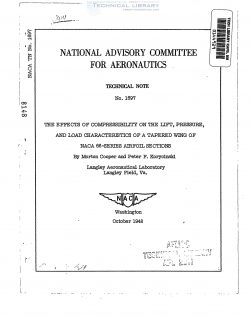naca-tn-1697
- Version
- 118 Downloads
- 2.56 MB File Size
- 1 File Count
- December 6, 2016 Create Date
- December 6, 2016 Last Updated
National Advisory Committee for Aeronautics, Technical Notes - The Effects of Compressibility on the Lift, Pressure, and Load Characteristics of a Tapered Wing of NACA 66-Series Airfoil Sections

Tests of a. l2—foot—span wing having 16—percent—thick NACA 66—series
sections, 2:1 taper ratio, and an aspect ratio of 6 have been conducted
in the Langley 16—foot high—speed. tunnel at Mach numbers up to 0.69 to
determine the effects of compressibility on the lift, pressure, and load.
characteristics of the wing.
The maximm lift coefficient increases from a value of 1.07 at a .
Mach number of 0.15 to a peak value of 1.135 at a Mach number of 0.25
and a Reynolds number of 3,500, 000, then decreases, more rapidly at
first, to a value of 0.895 at a Mach number of 0.50, after which it
' increases very rapidly to a value of 1.10 at a Mach number of 0.60
(limit of the maxiJmnn—lift tests). The increase in maximum lift coeffi-
cient at the higher Mach numbers is associated primarily with the
unusuale high acceleration of the flow around the sharp leading edge
of the wing and with the rearward movement of the shock formation
on the upper surface of the wing. At the lower Mach numbers serious
losses in maximum lift coefficient were found to result from premature
transitiOn of the laminar boundary layer to a turbulent boundary layer
caused by leading—edge roughness.
No significant changes in span load distribution and root bending—
moment coefficients occurred throughout the Mach number range for all
angles of attack: below the stall. For all Mach numbers investigated,
the spanwise distributiou of normal loads on the wing can' be predicted
adequately for most structural purposes. .
The formation of extensive local supersonic—flow regions over the
upper surface of the wing, with peak local Mach numbers as high as 1.75,
caused the center of pressure to move forward and thereby reduced the
section twisting-moment and root twisting-moment coefficients.
The significance of the interrelated. influence of Reynolds number
and Mach number in analyses of wind—tunnel maximum—lift data has been
Imam for several years. During tests of a three-dimensional wing of
NAGA 0012 airfoil sections (reference 1) at low Mach numbers (M < 0.37),
pronounced compressibility effects on the maximzm lift coefficient were
found in addition to the usual effects of Reynolds number on the maximum
lift coefficient. These adverse compressibility effects, which occurred
at relatively low speeds, were associated with the extremely high local
induced velocities over the wing at high angles of attack and with the
resultant inability of the flow to overcome the adverse pressure gradients.
| File | Action |
|---|---|
| naca-tn-1697 The Effects of Compressibility on the Lift, Pressure, and Load Characteristics of a Tapered Wing of NACA 66-.pdf | Download |
Comment On This Post